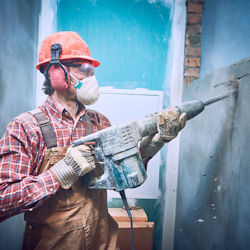Physical Health Hazards
Physical health hazards that employees face include excessive levels of ionizing and nonionizing electromagnetic radiation, noise, vibration, illumination, and temperature and humidity extremes.
Throughout the rest of this module, we'll briefly look at each of the following common types of physical hazards encountered by employees in the workplace. Industrial hygienists routinely analyze workplaces for these hazards and exposures.
Radiation: In occupations where there is exposure to ionizing radiation, time, distance, and shielding are important tools in ensuring worker safety. Danger from radiation increases with the amount of time one is exposed to it; hence, the shorter the time of exposure the smaller the radiation danger.
Noise: Noise, another significant physical health hazard, can be controlled by various measures. Noise can be reduced by controlling the noise at the source and by controlling exposure to the noise.
Temperature and humidity: Another physical hazard, radiant heat exposure in factories such as steel mills, can be controlled by installing reflective shields and by providing protective clothing.
Illumination: Illumination in the workplace is an important consideration. Inadequate or too much illumination in the work area can cause eye strain. Work environments that are too dark can possibly cause injuries from tripping and falling.
Ergonomics: Most workplace injuries and physical disorders are caused by the hazards associated with poor ergonomics. Strains, sprains, repetitive motion injuries, and musculoskeletal disorders are common in the workplace. Unfortunately, OSHA does not have specific mandatory standards that address proper ergonomics.
Knowledge Check Choose the best answer for the question.
2-4. Most workplace injuries and physical disorders are caused by the hazards associated with _____.
You forgot to answer the question!

